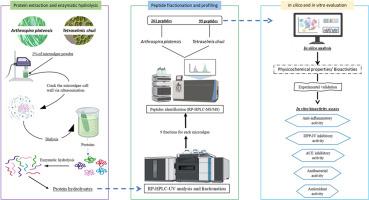platarthrospira和Tetraselmis chuii肽的鉴定和生物功能分析:计算机预测和体外验证
IF 3.8
Q2 BIOTECHNOLOGY & APPLIED MICROBIOLOGY
引用次数: 0
摘要
为了满足日益增长的对健康促进生物分子可持续来源的需求,本研究旨在从两种富含蛋白质且具有商业价值的微藻:platarthrospira和Tetraselmis chuii中鉴定和表征生物活性肽。这些物种的选择是基于它们的高蛋白含量、生态可持续性和潜在的未开发的功能肽储存库。采用优化后的超声提取方法从干燥的生物质中提取蛋白质,并以酶/底物(E/S)比为1:4的胃蛋白酶水解蛋白质。利用反相高效液相色谱-紫外分光光度法(RP-HPLC-UV)对platensis (APPH)和T. chuii (TCPH)蛋白水解产物进行分析,并将其分为9个部分(F1 ~ F9)。利用反相高效液相色谱-质谱联用技术对肽段进行鉴定,发现APPH中有261个独特肽段,TCPH中有99个独特肽段。使用机器学习工具进行物理化学性质、感官属性(鲜味、苦味)和生物活性(抗氧化、降压、抗炎、抗菌和神经活性)的计算机预测。通过体外实验,包括清除DPPH自由基、铁离子螯合、ACE和DPP-IV抑制、透明质酸酶抑制和抗菌测试,验证了这些结果。与TCPH相比,APPH的肽段具有更高的生物活性。其中,pph F4和F5对ACE的抑制作用为67.8%±0.8%,对DPP-IV的抑制作用为50.33±0.80%,对抗炎活性为37.90±1.57%,对DPPH的清除作用为66.2±3.7%。这些发现突出了平叶藻作为一种特别有前途的多功能肽来源。这种集成的蛋白质组学,计算和功能框架为微藻肽的发现提供了可扩展的管道,并支持创新功能食品和营养保健品的开发。本文章由计算机程序翻译,如有差异,请以英文原文为准。

Identification and biofunctionality profiling of peptides from Arthrospira platensis and Tetraselmis chuii: In silico predictions and in vitro validation
To address the growing demand for sustainable sources of health-promoting biomolecules, this study aimed to identify and characterize bioactive peptides from two protein-rich and commercially relevant microalgae: Arthrospira platensis and Tetraselmis chuii. These species were selected based on their high protein content, ecological sustainability, and potential as underexplored reservoirs of functional peptides. Proteins were extracted from dried biomass using an optimized ultrasonication and hydrolyzed with pepsin at an enzyme-to-substrate (E/S) ratio of 1:4. The resulting protein hydrolysates of A. platensis (APPH) and T. chuii (TCPH) were analyzed using RP-HPLC-UV and fractionated into nine fractions (F1 to F9). Peptides were identified using RP-HPLC-MS/MS, revealing 261 unique peptides in APPH and 99 in TCPH. In silico predictions of physicochemical properties, sensory attributes (umami, bitterness), and biological activities (antioxidant, antihypertensive, anti-inflammatory, antimicrobial, and neuroactive) were performed using machine learning tools. These were validated by in vitro assays, including DPPH radical-scavenging, ferrous-ion chelation, ACE and DPP-IV inhibition, hyaluronidase inhibition, and antibacterial testing. Peptide fractions from APPH consistently exhibited higher bioactivities than those from TCPH. In particular, APPH fractions F4 and F5 demonstrated the most potent activities, with 67.8 ± 0.8 % ACE inhibition, 50.33 ± 0.80 % DPP-IV inhibition, 37.90 ± 1.57 % anti-inflammatory activity, and 66.2 ± 3.7 % DPPH scavenging. These findings highlight A. platensis as a particularly promising source of multifunctional peptides. This integrated proteomic, computational, and functional framework offers a scalable pipeline for microalgal peptide discovery and supports the development of innovative functional foods and nutraceuticals.
求助全文
通过发布文献求助,成功后即可免费获取论文全文。
去求助
来源期刊

Biocatalysis and agricultural biotechnology
Agricultural and Biological Sciences-Agronomy and Crop Science
CiteScore
7.70
自引率
2.50%
发文量
308
审稿时长
48 days
期刊介绍:
Biocatalysis and Agricultural Biotechnology is the official journal of the International Society of Biocatalysis and Agricultural Biotechnology (ISBAB). The journal publishes high quality articles especially in the science and technology of biocatalysis, bioprocesses, agricultural biotechnology, biomedical biotechnology, and, if appropriate, from other related areas of biotechnology. The journal will publish peer-reviewed basic and applied research papers, authoritative reviews, and feature articles. The scope of the journal encompasses the research, industrial, and commercial aspects of biotechnology, including the areas of: biocatalysis; bioprocesses; food and agriculture; genetic engineering; molecular biology; healthcare and pharmaceuticals; biofuels; genomics; nanotechnology; environment and biodiversity; and bioremediation.
 求助内容:
求助内容: 应助结果提醒方式:
应助结果提醒方式:


